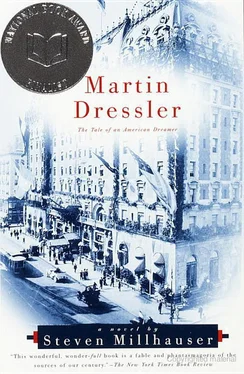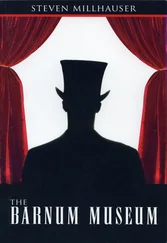In addition to the cigar stand, florist’s shop, newsstand, and railway-ticket office in the lobby, Martin wanted to install a barbershop and a beauty parlor. He was persuaded by the team of decorators to preserve the classic lines of the lobby and locate the new shops in the basement, in an area that could be made easily accessible by a new stairway. In the dim-lit basement passages, not yet wired for electric light, Martin imagined a subterranean street of small shops, stretching into the distance. The plan for a row of shops was opposed by Dundee as impractical, but in addition to the barbershop and beauty parlor Martin insisted on having space for a small pharmacy to supply the needs of guests, as well as for a notions shop filled with the buttons and shoelaces and ribbons that were perpetually in demand. By leasing the four shops he would quickly get back his investment; and he began to wonder whether he might be able to open a small gift shop, with sepia postcards showing views of El stations and East River ferries, sets of porcelain salt-and-pepper shakers shaped like bellboys and maids, cast-iron Broadway cable-car banks, tin wind-up express wagons drawn by two horses, toy wooden barges loaded with little barrels and sacks, and optical fountain pens that revealed, when you unscrewed the cap and held it to your eye, a tiny color transparency of the Brooklyn Bridge against a brilliant blue sky.
As carpenters began hammering in the basement, as plumbers and wallpaper hangers set to work in the first block of sealed-off rooms, Martin devoted a few hours each day to wandering the floors of the great department stores that had enchanted his boyhood. The attraction of the great emporiums, though it remained in some sense obscure to him, in another was luminously clear: he admired the stores as immense solutions to problems of organizing space, of bringing together in a complex harmony an astonishing number of often clashing notes. What struck him wasn’t so much the mingling of diverse merchandise in a great flow of departments as the ingenious inclusion of elements that ought to have clashed but didn’t: the tearooms and cafeterias where customers refreshed themselves in order to gain more energy for buying, the organ in the rotunda, the odd services — a bank, a barbershop — that seemed to make of each grand emporium a little enclosed city, a roofed city with an intricate system of elevators and stairs moving shoppers vertically through a world of attractions. One department store contained a dentist’s office, another a small theater. The idea was to lure customers in by means of skillfully arranged display windows and then to persuade them that they never had to leave, since everything they desired was immediately at hand. It struck him that what the stores really ought to do, if they wanted to keep customers there for as long as possible, was add several hundred parlor-and-bedroom suites. And as Martin pursued such thoughts, again he was struck by the kinship between the hotel and the department store, for each sought to attract and hold customers, each sought to be a little world in itself, each brought into a single large structure an immense number of juxtaposed objects serving a single idea. The department store and the hotel were little cities within the city, but they were also experimental cities, cities in advance of the city, for they represented in different forms the thrust toward vertical community that seemed to Martin the great fact of the modern city. That thrust was now being expressed in new forms, based on steel-frame construction, which allowed newspaper offices and insurance buildings to rise above the towering spire of Trinity Church; and Martin imagined great structures hundreds of stories high, each a city in itself, rising across the land.
From such imaginings he returned to the renovation of his six-story hotel, a small affair after all, though on the spot it loomed large enough. The operation was going to take longer than he had thought, some six months at least, as teams of workers moved by service elevator through carefully isolated portions of the hotel. Plumbing, Osborne explained, posed the trickiest problem. Since plumbing systems were vertical, it was difficult to leave access along all corridors while delivering materials to the bathrooms; the solution was a system of hoists erected outside the hotel, which permitted pipes and sinks to be brought in through the windows. Osborne showed himself to be expert at meeting complaints about noise and inconvenience, though even he proved helpless before the fury of guests when one of the new electric elevators stopped for six hours because of an electrician’s blunder. Martin followed closely the remodeling of rooms, sometimes with the exasperated sense that what was really needed was the utter annihilation of all the rooms in the hotel and their rebuilding in new patterns. One day, struck suddenly by the dullness of the etchings that hung in every room, etchings that showed the Grand Canal in Venice, or the Tower of London, or the Arc de Triomphe, he ordered them replaced by contemporary chromos: skaters in the Central Park, tugs and barges passing under the Brooklyn Bridge, fashionable women strolling along Ladies’ Mile, the yellow Moorish tower on Madison Square Garden with the gilded statue of Diana on top. Meanwhile he followed the expansion into the basement with sharp interest. He urged the carpenters to find room for another shop, and another, and he began to think of his basement shops as the Vanderlyn Bazaar, an attraction he planned to advertise.
The meticulously planned ad campaign had already begun in the daily papers and a handful of weeklies, where the New Vanderlyn was said to combine the amenities of a vanished way of life with every up-to-date convenience, but Martin planned to intensify the campaign as the renovation went forward. He needed some striking angle, some catchy device, and in moments of exuberance imagined painting the facade blue or erecting on the roof a fifteen-foot statue of George Washington or Pocahontas. A new hotel on Central Park West had advertised a croquet court on its roof — surely he could find something of the kind for the poor old Vanderlyn. But the poor old Vanderlyn resisted the showy and flamboyant, and Martin confined himself to a continual pressure of newspaper and magazine advertisement and a specially printed brochure that he distributed to the new travel agencies and made available in neat piles on the front desk. Extravagance would be confined to the official opening day, when he planned to release ten thousand balloons into the sky, hire an orchestra to play in the lobby, and invite journalists to a special dinner where he would pass out sealed envelopes, twenty of which contained a ticket allowing a free visit to the new barbershop.
Martin had fallen into the habit of discussing every detail of the business with Emmeline, who in turn reported the reactions of guests to the long renovation. “You’re going to make a success of it,” she said, “though of course you know that. You can tell they like it, like being in on big goings-on, even if they complain about little things. And the questions about the basement! A woman told me the other day she’d heard you were building a department store under the hotel.”
“Now there’s an idea,” Martin said. “I wish I’d thought of it myself.”
“Oh you have,” said Emmeline, “you have.”
She had thrown herself into her new job at the front desk with splendid zest. Martin saw that she was taken with the life of the lobby, with the sense of many lines of energy converging toward her from the elevators and the street, with her responsibility for providing comfort for strangers — and at the same time she revealed a gift for sympathy, for swift intelligent response, entirely lacking in an otherwise highly competent clerk like John Babcock. Her duties as part-time assistant consisted in accompanying him to wholesale furniture dealers and plumbing supply companies, making herself familiar with the working of all departments of the hotel, and reviewing accounts submitted to the Chambers Street office. And she was teaching herself how to type. She confessed to Martin that she had slipped his old book out from under Caroline’s radiator and replaced it with a block of wood.
Читать дальше












